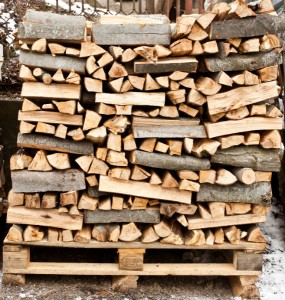A burning question for many homeowners with fireplaces is which types of wood are okay to burn and which are not. There is no simple answer to this question, as the options available to you are quite numerous. Nevertheless, they type of wood you burn has a direct effect on how quickly your chimney will need a cleaning.
There are two basic types of firewood, softwood and hardwood. Softwoods—pines, spruces and firs—start burning easily. Typically, these woods have less potential BTU [British Thermal Unit] energy than hardwoods. Softwoods also smoke much more than their hardwood counterparts. The one true advantage softwood has is that it lights very quickly because it’s less dense; this quality makes it an excellent choice for kindling for any fire. Hardwoods—oaks, maples and cedars—on the other hand, don’t start burning quite as easily but burn for a long time. Per square inch, when compared to softwoods, they have much more BTU potential than other types of wood and, therefore, burn hotter and more steadily.
The easiest and best fire is built by using a mixture of both softwoods and hardwoods. A bed of ashes underneath the grate produces steady heat and aids in igniting new fuel as it‘s added. This will ensure that the fire will continue burning as long as small amounts of wood are added at regular intervals. As a matter of fact, more efficient wood burning results from burning small loads of wood with sufficient air than from burning large loads of wood with minimal air.
It’s also important to season your firewood, whether it’s hard or soft, as all of it contains moisture. Seasoning takes place when the moisture content in the wood reaches equilibrium with that of the surrounding air. A common method of seasoning wood is simply stacking it outdoors in a spot that allows for good air circulation and is dry, sunny and open for approximately six months out of the year. Seasoning in this manner will produce wood that is dry enough to support efficient combustion and has a higher heating value than unseasoned wood.
It is far more important that your firewood be dry and seasoned as compared to what type of wood you’re burning. Having both soft and hardwood on hand is a good idea. You can use the softer woods for kindling and for fires during cooler months when only a small amount of heat output is desired and save the harder woods for the coldest months. Keeping these things in mind will make you a much happier homeowner and will make the cold months of the year much more enjoyable for you and your family.

